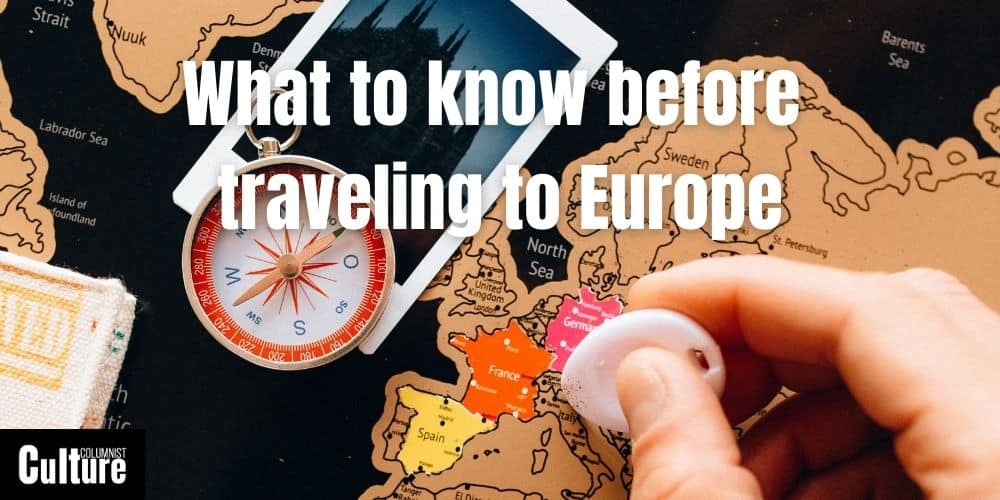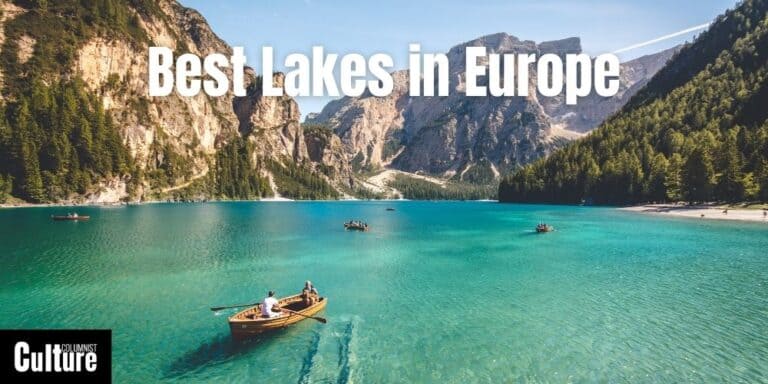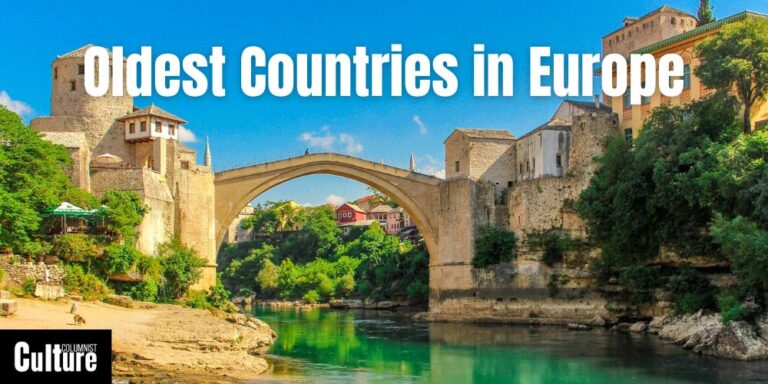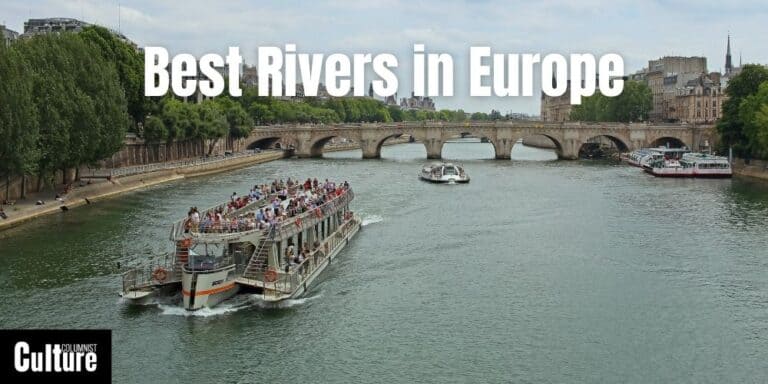What To Know Before Going To Europe
Europe is a continent in the Northern Hemisphere, located on the far west peninsula of the Eurasian landmass, and is the second-smallest continent in the world by landmass. It is bordered by the continents of Asia to the west, separated by the Ural Mountains; Africa to the south, separated by the Mediterranean Sea; and North America to the west, separated by the Atlantic Ocean.
The European continent contains 44 countries (including western Russia and excluding transcontinental countries: Turkey, Kazakhstan, Azerbaijan, Georgia, Armenia, and Cyprus) and has a population of 741,937,458 million people as of 2024, making it the third-largest continent in the world in terms of population.
Including transcontinental countries, Europe has 50 countries. Europe is considered one of the most developed continents in the world in terms of economy, education, health, culture, and tourism, and is the continent with the third highest gross domestic product in the world.
Where is Europe on the world map?
On the world map, Europe is located in the central part of the Northern Hemisphere. The water bodies that border Europe’s coastline are the Atlantic Ocean to the west, the Arctic Ocean to the north, and the Mediterranean, Black Sea, and Baltic Sea to the south.
Europe is 510 kilometers from North America to the west; 1,050 kilometers from Asia in the east; and 730 kilometers from Africa in the south. One of the most important mountains in Europe is the Greater Caucasus, which forms part of the Caucasus Mountain Range and is located in the east of Europe, stretching from the Black Sea to the Caspian Sea, where Europe’s highest point is located at 5,642 meters (18,510 feet).
47% of Europe’s landmass is covered with forests, and the continent’s most well-known forests are Białowieża forest, straddling Poland and Belarus, and the Wild Taiga forest in eastern Finland.
What is the geolocation of Europe?
In terms of mathematical location, Europe is located at 54.5260° north latitude and 15.2551° east longitude.
What are the neighboring countries of Europe?
The European Union, including it’s overseas territories, shares land borders with 20 countries. The neighboring countries of continental Europe are Russia to the east and Turkey to the southeast. Where transcontinental countries are included in the definition of Europe, neighboring countries include Syria, Iraq, Iran, and Khazakstan.
What are the boundaries of Europe?
The European Union has land borders with a total length of 14,111.4 kilometers (8,769.71 miles). The coastline borders the Atlantic Ocean, Mediterranean Sea, Black Sea, and Baltic Sea and is estimated to be 66,000 km (41,000 miles) long.
The border lengths of continental Europe, including the transcontinental countries of Turkey, Georgia, Armenia, and Azerbaijan, are 911 kilometers (566 miles) with Syria, 367 kilometers (228 miles) with Iraq, and 1,267 kilometers (787 miles) with Iran.
The border lengths of continental Europe, excluding the transcontinental countries of Russia, Turkey, Georgia, and Azerbaijan, are: 2,250 kilometers (1398 miles) with Russia across five countries; 713 kilometers (439 miles) with Turkey; 894 kilometers (556 miles) with Georgia; and 338 kilometers (210 miles) with Azerbaijan.
What hemisphere is Europe in?
Europe is located in the central part of the Northern Hemisphere, between the continents of Asia and North America.
What is the area of Europe?
The EU, including all overseas territories, is 4,236,351 square kilometers and represents the seventh largest territory in the world by area. Continental Europe has an area of around 10.18 million square kilometers (3.93 million square miles), or 2% of Earth’s surface. The area of Europe gives it a geographical advantage. The population density in Europe is 34 people per square kilometer (87 people per square mile), according to the Worldometer.
What is the population of Europe?
The population of Europe (excluding Eastern Russia, Turkey, Georgia, Armenia, Azerbaijan, and Cyprus) in 2024 is 741,936,235, according to Worldometer. The population of Europe (including Eastern Russia, Turkey, Georgia, Armenia, Azerbaijan, and Cyprus) in 2024 is 954,331,393.
In terms of population size, Europe ranks 3rd in the world after Asia and Africa. The average age of the European population is 44.4, while the average life expectancy in Europe is recorded at 80.1 years, according to data from the European Commission.
Population censuses in Europe are held every 10 years. The population of the EU has increased from 446.7 million in 2022 to 448.4 million in 2023.
What timezone is Europe?
The European continent spans four standard time zones; Europe’s Four Main Time Zones are Western European Time (WET), also referred to as Greenwich Mean Time (GMT), Central European Time (CET), Eastern European Time (EET), and Further-Eastern European Time (FET), also called Moscow Time (MSK).
GMT countries include the United Kingdom, Ireland, the Netherlands, Belgium, Luxembourg, France, Andorra, the Canary Islands, and Portugal. CET countries include Denmark, France, Germany, Hungary, Mainland Spain, and Switzerland. EET countries include Finland, Greece, Latvia, and Romania. FET countries include Russia, Belarus, Turkey, and Northern Cyprus.
What is the time difference between eastern and western Europe?
The difference between Western European Time (WET) and Further-Eastern European Time (FET) is 3 hours. The difference between Western European Time (WET) and Eastern European Time (EET) is 2 hours. The difference between Western European Time (WET) and Central European Time (CET) is 1 hour. The small time difference between eastern and western Europe positively affects transportation and facilitates travel around the continent.
What is the language of Europe?
Europe has over 200 languages spoken across the continent; some are considered official languages for political purposes, and others are spoken by minority populations but are still considered languages of Europe.
The European Union has 24 official languages: Bulgarian, Croatian, Czech, Danish, Dutch, English, Estonian, Finnish, French, German, Greek, Hungarian, Irish, Italian, Latvian, Lithuanian, Maltese, Polish, Portuguese, Romanian, Slovak, Slovenian, Spanish, and Swedish.
The most prominent language family in Europe is the Indo-European family, which includes: Romance Languages: such as French, Spanish, Italian, Portuguese, and Romanian; Germanic Languages: such as English, German, Dutch, Swedish, Danish, and Norwegian; and Slavic Languages: such as Russian, Polish, Czech, Slovak, Ukrainian, Bulgarian, and Serbian.
What are the most spoken languages in Europe?
The most spoken languages in Europe are listed below.
- Russian
- German
- French
- Turkish
- Italiam
- English
- Spanish
- Polish
- Ukrainian
- Dutch
Russian is the most spoken language in Europe, with 221 million native speakers. While there are only 63 million native English speakers in Europe, it is the most commonly spoken language on the continent, with over 370 million people speaking it in some form.
Some countries have higher English proficiency rates than others, particularly in Scandinavia, western Europe, and central Europe, whereas eastern and southern Europe have lower English proficiency rates in general. For someone going to Europe, knowing a good level of English is enough to navigate major cities, tourist sites, and most hotels.
What alphabet is used in Europe?
Latin, Cyrillic, and Greek are the three alphabets used in Europe. The Latin alphabet is the most used. It is a collection of letters originally used to write the Latin language in ancient Rome but is still used today in Romance languages such as Italian, Spanish, and French, Germanic languages such as German and English, and some Slavic languages like Polish, Czech, and Slovak.
The Cyrillic alphabet is the second most-used alphabet in Europe and is mostly used in eastern European countries such as Russia, Belarus, and Ukraine. The Greek alphabet is the third most-used alphabet in Europe and is used in Greece and Cyprus.
What is the European international telephone area code?
The international dialing area and country codes for Europe are:
- Albania +355
- Andorra +376
- Armenia +374
- Austria +43
- Azerbaijan +994
- Azores Islands +351
- Belarus +375
- Belgium +32
- Bosnia and Herzegovina +387
- Bulgaria +359
- Croatia +385
- Czech +420
- Denmark +45
- Estonia +372
- Faroe Islands +298
- Finland +358
- France +33
- Georgia +995
- Germany +49
- Gibraltar +350
- Greece (Hellenic Rep.) +30
- Greenland +299
- Hungary +36
- Iceland +354
- Ireland +353
- Italy +39
- Kazakhstan +7
- Kyrgyz Rep. +996
- Latvia +371
- Liechtenstein +423
- Lithuania +370
- Luxembourg +352
- Macedonia +389
- Malta +356
- Moldova +373
- Monaco +377
- Netherlands +31
- Norway +47
- Poland +48
- Portugal +351
- Romania +40
- Russian Federation +7
- San Marino +378
- Serbia and Montenegro +381
- Slovakia +421
- Slovenia +386
- Spain +34
- Sweden +46
- Switzerland +41
- Tajikistan +992
- Turkey +90
- Turkmenistan +993
- Ukraine +380
- United Kingdom +44
- Uzbekistan +998
- Vatican +39
To call a European country from anywhere else in the world, you must first dial the country code and then the number to be called.
What is the domain extension for Europe?
Europe’s internet extension is “.eu”. As of October 2023, there are a total of 3.72 million registered websites ending with the eu domain extension, and there is no need to submit an official document to buy a domain with an “.eu” extension.
What is the abbreviation for Europe?
The abbreviation for Europe is EUR, or EU.
What is Europe’s zip code?
There is no single European postcode or zip code for Europe. Every country within Europe uses different codes.
What are European cities?
The 51 main cities in Europe, according to population are:
- Paris
- Budapest
- Rome
- Prague
- Barcelona
- Vienna
- Munich
- Madrid
- Berlin
- London
- Warsaw
- Lisbon
- Milan
- Amsterdam
- Copenhagen
- Athens
- Hamburg
- Sofia
- Bucharest
- Tallinn
- Stockholm
- Cologne
- Florence
- Seville
- Saint Petersburg
- Moscow
- Helsinki
- Brussels
- Kyiv
- Dublin
- Antwerp
- İstanbul
- Bratislava
- Kraków
- Riga
- Belgrade
- Reykjavík
- Zagreb
- Minsk
- Birmingham
- Kharkiv
- Málaga
- Dubrovnik
- Bologna
- Vilnius
- Bruges
- Frankfurt
- Odesa
- Gdańsk
- Espoo
- Hanover
Moscow is the largest city in Europe in terms of both population and area. Vatican city is considered the smallest city in Europe with only 900 residents.
How many cities are there in Europe?
There are over 800 cities with more than 50,000 inhabitants in Europe.
What is the capital city of Europe?
Brussels is often considered the political capital of the European Union and, by extension, Europe. However, Europe does not have one single official capital city. It has over 50 capital cities.
How is the economy in Europe?
The European economy is the collective economy of over 50 sovereign states, each with its own unique economic structure, policies, and stage of development.
A significant part of Europe’s economy is integrated through the European Union. This economic union consists of 27 member states with a single market allowing the free movement of goods, services, and labor, 19 of which have adopted the Euro (€) as their official currency, forming the Eurozone.
Europe’s economy ranges from highly developed economies in western Europe and northern Europe, known for their high standard of living and strong tourism sector, to emerging markets in eastern and southern Europe, which include economies that are more dependent on agriculture as well as tourism.
The most developed industrial sectors in Europe are the automotive, aeronautics, chemicals, energy, and pharmaceutical industries. While the most exported products from Europe are motor vehicles and chemicals, the most imported products include mineral fuels, oils and distillation products.
Tourism is an important economic activity in Europe, accounting for 10% of GDP in the European Union. Tourism-related activities range from 5 to 20 percent of GDP across different European countries and have a wide-ranging impact on economic growth and social development. For most countries in southern Europe, including Greece, Croatia, and Portugal, travel and tourism are vital to their economies.
What is the currency of Europe?
The euro is the official currency of many countries in Europe, including Germany, France and Spain. In total, 20 European countries have adopted the euro as their common currency.
They are: Austria, Belgium, Croatia, Cyprus, Estonia, Finland, France, Germany, Greece, Ireland, Italy, Latvia, Lithuania, Luxembourg, Malta, the Netherlands, Portugal, Slovakia, Slovenia and Spain. Its international symbol is € It can be readily exchanged in most other non euro countries in Europe for the local currency.
European countries that do not use the euro include the United Kingdom, which uses the British Pound Sterling (£), Switzerland, which uses the Swiss Franc (CHF), Norway, which uses the Norwegian Krone and Sweden, which uses the Swedish Krona. Additionally, some EU member states, such as Poland and Hungary, have not adopted the Euro and continue to use their national currencies (Polish Zloty and Hungarian Forint).
What is Europe’s Per Capita National Income?
The per capita income in the European Union in 2021 was $31,458, according to the World Bank. In terms of per capita income, Europe ranks third in the world among other continents. The per capita income in Europe has increased since 1970 from $1,648 to $31,458. In 2023, the minimum wage in EU Member States ranged from €399 per month in Bulgaria to €2,508 per month in Luxembourg, according to the European Commission.
What is Europe’s GDP?
The GDP in Europe was $36,732 billion in 2023, according to the International Monetary Fund. Europe ranks second in the world in terms of GDP compared to other continents and represents 20% of the global economy.
What is the HDI of Europe?
European countries rank highly among the rest of the world in the 2021 Human Development Index. The average for 2021, based on 44 countries, was 0.878 points. The highest value was in Switzerland: 0.962 points, and the lowest value was in Moldova: 0.767 points.
A total of 38 countries in Europe have scores over 0.800, indicating very high levels of development. Among the factors that enable European countries to rank highly in the Human Development Index are life expectancy, per capita income, and increasing education levels.
What is the happiness rating in Europe?
Europe scored an average of 6.63 points based on 27 countries in the 2022 World Happiness Report, 1.09 points higher than the global average of 5.54 points based on data from 134 countries. The highest value was in Finland: 7.8 points, and the lowest value was in Bulgaria: 5.47 points. Among the features that enable Europe to be above average in the happiness ranking are factors such as welfare, quality of life, diversity of cultural activities, and education level.
What is Europe’s military strength?
There are 38 European countries listed in the 2024 GFP Power Index, where a perfect power score is 0.0000. Russia has the highest PwrIndx score among European countries, with a score of 0.0702. Moldova has the lowest PwrIndx score among European countries, with a score of 4.2311. The average military strength among the 38 European countries listed is approximately 1.1652, which is 0.2941 more powerful than the global average of 1.4593.
What are the politics in Europe?
The political structure in Europe is dominated by the European Union. All European Union member states are representative democracies; however, they do not all have the same political system but instead a variety of government systems, including parliamentary democracies, presidential republics, and constitutional monarchies.
The European Parliament is one of the key institutions of the European Union, playing a crucial role in the EU’s democratic processes and sharing legislative power with the Council of the European Union.
It is composed of Members of the European Parliament (MEPs). The number of MEPs from each country is roughly proportional to the population of that country, but no country can have fewer than 6 or more than 96 MEPs. As of April 2023, there are 705 MEPs.
The European Union operates under a set of treaties that serve a similar purpose as a constitution. The most important of these are: the Treaty of Rome (1957), the Maastricht Treaty (1992), the Treaty of Amsterdam (1997), the Treaty of Nice (2001), and the Lisbon Treaty (2007).
What is the government in Europe?
Each country in Europe has its own government, and these vary significantly in form:
Many European countries, like the United Kingdom, Germany, Spain, and Italy, have parliamentary systems where the government is elected by and accountable to the parliament. Some countries, like France and Russia, have a president who is either directly elected by the people or plays a significant role alongside the parliament.
Countries like the United Kingdom, Sweden, and the Netherlands have monarchs with limited powers, where real political power is held by elected parliaments. Some countries are federal (like Germany and Belgium, where power is divided between central and regional governments), while others are unitary states (like France and Portugal, where power is centralized).
What is the European Union?
The European Union (EU) is an economic and political union between 27 European countries that encompasses much of the continent. Established after World War II, the union was designed to promote economic cooperation and prevent conflict among European nations. Over time, the EU has evolved into a single market where goods, services, people, and capital can move freely over national borders between member states.
Is the EU its own country?
No, the European Union (EU) is not its own country. While it has its own currency (the Euro, used by 19 of the member countries), a parliament, and other institutions that exercise supranational authority, it does not replace the sovereignty or the individual governments of its member countries.
What is Europe’s Schengen zone?
The Schengen Zone is an intergovernmental agreement originally between five EU countries—France, Germany, Belgium, the Netherlands, and Luxembourg—and has gradually expanded to become the largest free travel area in the world. It is named after the 1985 Schengen Agreement, which was signed in the village of Schengen in Luxembourg.
Today, it comprises 27 European countries that cover nearly all of mainland Europe and allow more than 400 million people to travel freely between member countries without passport checks and a common visa policy at their mutual borders, whether they are citizens of Schengen countries or visitors. This means that a visa issued by one Schengen country is generally valid for travel to all other Schengen countries.
Is Europe in NATO?
There are 29 European countries that form part of NATO’s 31 member states. The five EU member states that are not members of NATO are Austria, Cyprus, Ireland, Malta, and Sweden, which officially hold positions of neutrality in international conflict. The 29 European countries in NATO are:
- Albania joined 2009
- Belgium joined 1949
- Bulgaria joined 2004
- Croatia joined 2009
- Czech Republic joined 1999
- Denmark joined 1949
- Estonia joined 2004
- Finland joined 2023
- France joined 1949
- Germany joined 1955
- Greece joined 1952
- Hungary joined 1999
- Iceland joined 1949
- Italy joined 1949
- Latvia joined 2004
- Lithuania joined 2004
- Luxembourg joined 1949
- Montenegro joined 2017
- Netherlands joined 1949
- North Macedonia joined 2020
- Norway joined 1949
- Poland joined 1999
- Portugal joined 1949
- Romania joined 2004
- Slovakia joined 2004
- Slovenia joined 2004
- Spain joined 1982
- Turkey joined 1952
- United Kingdom joined 1949
What are the symbols of Europe?
The symbols of Europe are:
- Europa and the Bull
- Europa Regina
- Pater Europae (Father of Europe)
- Patron Saints of Europe
- Flag of Europe
- Pan-European Flags Before 1955
What is the flag of Europe?
The flag of Europe, often associated with the European Union (EU), consists of a circle of twelve gold stars on a blue background. The number of stars remains constant at twelve, representing perfection and completeness, and is not affected by the number of EU member states. The design symbolizes the unity, solidarity, and harmony among the peoples of Europe.
What is Europe known for?
Europe is known as being a key center of trade and commerce, with many of the world’s most famous cities. It is the birthplace of Western civilization and a fascinating travel destination that boasts a tapestry of traditions, languages, cuisines, music, folklore, arts, literature, and beautiful landscapes.
It is home to a diverse range of countries, each with its own unique history and culture, and its wilderness areas are just as varied, offering more than 400 UNESCO World Heritage Sites and stunning natural scenery that contrasts with its urban sophistication.
What is transportation like in Europe?
Transportation in Europe is generally well developed with advanced infrastructure. Most European countries drive on the right-hand side of the road, except for the United Kingdom, Ireland, Cyprus, and Malta, where they drive on the left.
Major cities like London, Paris, Rome, and Berlin can experience heavy traffic, especially during rush hours, which are typically weekdays at 7-9 AM in the morning and 4-7 PM in the evening. Traffic congestion can be an issue in many European cities, and public transport systems are widely used.
Major European cities have wide-reaching and efficient public transport networks like trams and metros, whereas buses and trains are more commonly used in rural areas. Cycling is popular in countries like the Netherlands and Denmark. Europe has an extensive rail network that allows high-speed trains like France’s TGV, Germany’s ICE, and Spain’s AVE to connect major cities across countries rapidly.
Speed limits in Europe vary by country and the type of road. Common traffic rules include mandatory seatbelt use, drink-driving limits, and minimum vehicle safety standards. The countries with the safest roads in Europe are Sweden (22 deaths per million inhabitants) and Denmark (26 deaths per million), while Romania (86 deaths per million) and Bulgaria (78 deaths per million) had the highest fatality rates in 2022, according to the European Commission.
How is education in Europe?
Each European country has its own education system, with policies and curricula set by national or regional authorities. Education in Europe typically follows a format of primary, secondary, and tertiary (higher) education. Compulsory education usually starts at ages 5–7 and continues until 16–18.
Primary education focuses on basic skills and foundational knowledge. Secondary education often splits into academic and vocational tracks, with students having the option to pursue more specialized education tailored to their interests and career aspirations.
Europe is home to 34 of the world’s top 100 universities and higher education institutions. The Bologna Process has harmonized higher education across Europe with a three-cycle system of Bachelor’s, Master’s, and Doctoral degrees. This system facilitates the recognition of qualifications and student mobility across countries.
What is the social structure of Europe?
The social structure of Europe consists of both modern and traditional values. Europe, which consists of many different nations and ethnic groups who live together, has a multicultural social structure. The political thought of European society is concentrated in the views of democracy and human rights, although some countries in Europe are more conservative than others.
There were 0.7 million divorces in Europe in 2021, according to data from the European Commission. Equality between women and men is strongly advocated in Europe, and there are many organizations and laws that aim to protect women’s rights.
Freedom of speech is respected in Europe. Article 10 of the European Convention on Human Rights protects freedom of speech and the right to exchange information and ideas regardless of frontiers. The average crime rate in Europe in 2021 was less than the global average. Europe has very little violent crime, but pickpockets and purse-snatchers can be a problem in busy tourist areas.
The ease of movement across borders in Europe, especially within the Schengen Area, facilitates cultural exchange. People from different countries interact, share ideas, and learn from each other, leading to a more diverse and multicultural society, particularly in major cities.
Travel and tourism are deeply ingrained in European culture. This not only boosts the economy but also fosters a societal norm where travel is seen as a valuable experience for personal growth, education, and leisure.
The positive economic impact of travel and tourism contributes to the overall quality of life in European countries. This includes better infrastructure, preservation of cultural sites, and improved public services, all of which benefit both residents and visitors.
What is European culture?
European culture is marked by a strong appreciation for the arts, including literature, music, film, and visual arts, with each country contributing its own distinct flavors and styles. This diversity is further enriched by the evolution and fusion of different cultures over time, making it a dynamic and ever-evolving tapestry.
European culture has been shaped by numerous events throughout history, including:
- The birth of Western philosophy, democracy, literature, and art in ancient Greece and Rome.
- The spread of Christianity as the dominant religion.
- The Renaissance, originating in Italy in the 14th century, marked a period of cultural, artistic, and intellectual revival, leading to advancements in art, science, and exploration.
- In the 16th century, the Protestant Reformation led by figures like Martin Luther and John Calvin
- The 17th and 18th centuries’ Enlightenment era fostered new ideas about reason, individualism, and skepticism of traditional authority, influencing political thought, science, and culture.
- The Industrial Revolution of the late 18th century brought about dramatic changes in technology, economy, and society, leading to urbanization and a new social order.
- The two World Wars in the 20th century reshaped borders and societies, leading to significant political and cultural changes.
- The ideological and political divide between the Western bloc and the Eastern (Soviet) bloc during the Cold War
- The fall of the Berlin Wall and the collapse of the Soviet Union in 1989 and 1991, respectively, marked the end of the Cold War, leading to the reunification of Germany and significant political and cultural shifts in Eastern Europe.
- The formation and expansion of the European Union have facilitated increased cultural exchange and cooperation among member states, contributing to a more integrated European identity.
What are the cultural characteristics of Europe?
The cultural characteristics of Europe are shaped by the diverse heritages and histories of its many nations. Each country presents its own set of traditions, architectural styles, cuisines, and languages, making a journey across Europe a diverse and enriching experience.
Europe’s emphasis on preserving its heritage while embracing modernity means that travelers can enjoy both the charm of ancient history and the comforts of contemporary advancements. The blend of different cultures, cuisines, arts, and historical sites in close proximity makes Europe a multifaceted cultural experience.
Despite technological developments and digitalization, Europe preserves its heritage, ancient sites, and traditions while embracing modernity, which means that travelers can enjoy both the charm of traditional and contemporary cultural experiences. Furthermore, the diversity of different cultures, cuisines, arts, and historical sites in such close proximity in Europe makes it a multifaceted place to visit.
What is the architecture of Europe?
European architecture reflects the continent’s long history and varied cultural influences. It encompasses a wide range of styles, each corresponding to different historical periods and cultural movements, including classical, romanesque, gothic, renaissance, baroque, neoclassical, modernist, postmodern, and contemporary architecture.
The Colosseum in Rome, Italy, represents classical Roman engineering. The Notre-Dame Cathedral in Paris reflects the medieval period’s Gothic architecture, and the Sagrada Família in Barcelona, by Antoni Gaudí, represents a blend of Gothic and Art Nouveau.
Filippo Brunelleschi, the architect of the dome of the Florence Cathedral; Sir Christopher Wren, the architect of St. Paul’s Cathedral; and Gustave Eiffel, the architect who completed the Eiffel Tower, are considered among the important European architects.
What is European cuisine?
European cuisine is predominantly associated with breads, cheeses, pastries, desserts, wines, and beer, with each region having its own specialties, unique dishes and cooking styles, shaped by local ingredients, climate, and historical influences. European cuisine encompasses a wide range of diverse and rich culinary traditions from different cultures, with the predominant cuisines being those of Italy, France, and Spain.
Europeans typically eat a light breakfast that often includes bread or pastries, cheese, cold cut meats, yogurt, cereal, fruit, and coffee or tea, while heavier breakfasts can be found in countries like the UK or Ireland.
The continental breakfast is mainly associated with Europe. It is named after the continental countries of Europe and consists of baked goods such as bread, croissants, and pastries, along with butter, jam, and honey. It often includes coffee, tea, or hot chocolate and may also feature fruit, yogurt, and sometimes cheese or cold cuts of meat. It has since become popular in hotels and accommodations around the world as a quick, light option for travelers.
For Europeans, lunch and dinner vary widely by country and region. Lunch is often the main meal of the day in southern Europe, typically consisting of multiple courses including pasta, meat or fish, vegetables, and salad. Lunch tends to be lighter in Northern and Central Europe, often involving sandwiches, soups, or salads.
Dinner across Europe usually involves a main course featuring meat or fish, accompanied by vegetables, potatoes, rice, or pasta. In southern European countries, dinner is often served later in the evening and may include multiple courses. Dinner is typically the main meal of the day in Northern and Central Europe and is usually served earlier in the evening.
Who are Europe’s famous artists?
Famous European artists have historically produced works mostly in the fields of music, literature, and painting.
European authors such as Shakespeare, Tolstoy, and Joyce are included in world literature; European musicians such as Mozart and Beethoven have contributed significantly to classical music; and European painters such as Leonardo da Vinci, Pablo Picasso, and Vincent van Gogh have contributed significantly to the world of art.
Famous European artists include:
- Leonardo da Vinci
- Michelangelo Buonarroti
- Vincent van Gogh
- Pablo Picasso
- Rembrandt van Rijn
- Claude Monet
- Johannes Vermeer
- Salvador Dalí
- Francisco Goya
- Albrecht Dürer
What are the crime rates in Europe?
The average crime index score in Europe is 37.8, 7.72 below the world average crime of 45.52, based on data from 142 countries around the world. Nevertheless, crime rates vary from one European country to another, and some European countries are much safer than others.
Belarus is the European country with the highest crime index score of 56.4, while the Isle of Man and Switzerland have the lowest crime index scores in Europe, at 18.0 and 23.6, respectively. When comparing the average crime index score in Europe to the average score of other continents, it can be said that less crime is committed in Europe than in other continents.
What are the living conditions in Europe?
Living conditions in Europe are high due to the fact that Europe has a developed economy, the per capita income is high, and the minimum wage purchasing power is high. Generally, European people do not experience economic difficulties.
The high standard of living is also due to well-maintained public spaces, reliable public transportation, and a wide range of dining and shopping experiences. Europe is generally considered safe, with low crime rates in most areas, which means both the cities and countryside pose minimal concern for personal safety.
Europe has excellent healthcare facilities. EU countries offer reciprocal healthcare agreements for EU citizens, and many world travel insurance policies cover healthcare in Europe. There is a high standard of preservation and accessibility for cultural and historical sites such as museums, historical landmarks, and cultural events.
Europe’s diverse climate means people can enjoy a variety of experiences depending on the region and season, from Mediterranean beaches in summer to Alpine skiing in winter. This varied climate contributes to a diverse harvest with high quality produce that has allowed for a diverse range of culinary traditions to develop and an array of different dining experiences.
Although traffic density is high in Europe, it varies from city to city. Europe’s extensive and efficient public transportation networks, including buses, trams, trains, and flights, make it easy to travel between and within countries.
What religions are believed in Europe?
In Europe, 72.23% of the population is Christian. Besides Christianity being the most widely believed religion, there are also religious beliefs such as Islam, Hinduism, Buddhism, and Judaism. The percentage of different denominations in Europe is 48% Roman Catholic, 32% Orthodox, and 27.2% Protestant.
In Europe, atheists are individuals who do not believe in any religion and make up approximately 20% of society.
What is the biggest event in the history of Europe?
Among the 3 major events in the history of Europe are the fall of the Western Roman Empire, symbolizing the end of the ancient empires and the beginning of the Middle Ages; the Renaissance, a period of great cultural, artistic, political, and scientific revival, marking a transition from the Middle Ages to modernity; and World War II, the most devastating global conflict in history, which led to significant political, economic, and social changes in Europe, including the formation of the European Union.
What is the geography of Europe?
Europe’s landforms consist of mountains, lakes, rivers, plains, glaciers, volcanoes, and forests. The Mediterranean coastline, with it’s sandy beaches and cliffs in southern Europe; mountain ranges like the Alps, the Appenines, and the Pyrenees and meandering rivers in central and western Europe; fjords and arctic tundra with a vast number of islands and lakes in northern Europe; plains and forests in the eastern parts; as well as the Carpathian and Caucasus mountain ranges.
The highest point in Europe is Mount Elbrus in Russia, part of the Caucasus Mountains, standing at 5,642 meters (18,510 feet). The deepest known part of Europe in a lake is the Hornindalsvatnet in Norway, which reaches a depth of 514 meters (1,686 feet). The largest forest in Europe is the European part of the Russian Taiga, also known as the Boreal Forest, which spans across much of northern Russia and Scandinavia. The geography of Europe contains many natural wonders, including mountains, rivers, forests, and plains.
What is Europe’s climate like?
Europe’s diverse climate and vegetation vary significantly across its different regions.
Northern Europe, including Scandinavia, Iceland, and northern parts of Russia, sees very cold winters, often dropping below -20°C in some parts, while summer temperatures do not usually rise above 25°C. The predominant climate types are subarctic and tundra, with coastal areas experiencing milder maritime and oceanic climates, allowing for coniferous forests like spruce and pine trees to grow.
Western Europe, including the UK, Ireland, the Netherlands, and northern France, experiences mild winters, with temperatures rarely falling below 0°C and summers rarely rising above 30°C. The climate is characterized by mild temperatures and frequent rainfall. Deciduous forests with oak, beech, and elm trees are common thanks to the climate, as are fruits such as apples, pears, and plums.
Central and much of eastern Europe, including Germany, Poland, the Czech Republic, Slovakia, and Hungary, but also Ukraine, Belarus, and parts of Russia, experience cold winters, dropping below 0°C, while summers can be warm, reaching up to 30°C. This region is characterized by a continental climate with greater temperature extremes than Western Europe. Mixed forests with trees like spruce, pine, and fir are common, as are fruits like apples, cherries, and grapes, thanks to the climate.
Southern Europe, including Italy, Spain, Greece, and Portugal, experiences mild to cool winters, with temperatures rarely falling below 5°C and hot summers often exceeding 30°C but rarely above 40°C. The Mediterranean climate, characterized by hot, dry summers and mild, wet winters, is conducive to shrubs like myrtle, thyme, rosemary, olive, and cork oak trees, as well as fruits like grapes, citrus fruits, and figs.
What other continents are similar to Europe?
North America is the continent most similar to Europe in terms of architecture, cultural, economic, and social structure.
How do you get to Europe?
It is possible to reach Europe from anywhere in the world by air. Land and sea routes are also possible but are less common methods for traveling to Europe due to long-distances. Air travel to Europe takes between 6 and 8 hours from North America’s east coast and 10-13 hours from the west-coast. Transatlantic passenger service between Europe and the United States usually takes 7 nights.
Do you need a travel agent to go to Europe?
No, you do not need a travel agent to go to Europe. Many travelers enjoy trips to Europe independently, with the help of informative travel guides that allow you to plan your trip to Europe successfully. However, whether or not you book your trip to Europe through a travel agent, it is always beneficial to read travel guides to gather tips, ideas, and inspiration for your trip.







